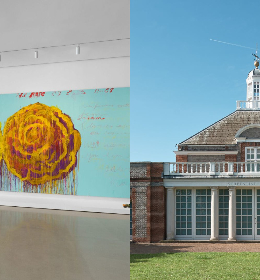Historically, it was difficult to release the value of your art collection without making a sale, but in recent years a growing number of solutions have emerged to help investors access the value of their assets while retaining ownership.
This has increased the attractiveness of art as an asset class, says Rayah Levy, founder of art investment company ArteQuesta. “Being able to use art as collateral has positioned art as one of the firmest and most conservative approaches to growing wealth,” she says. “As many investors and financial institutions have become over-leveraged, the value of artwork is a clear source to create liquidity.
“Right now, borrowing against the value of your art is a good idea for those who may not necessarily want to sell their artwork but want to utilize their collection for liquidity or to finance other projects. The interest rates are competitive and almost every major bank and financial institution now loans against artwork.”

Rayah Levy © ArteQuesta
Levy notes that the main problem for borrowers can be that the artwork cannot be sold while it is encumbered, so the asset is frozen until the loan or line of credit is paid off.
“Ultimately this is not a major issue because if the owner wants to sell the artwork for a record price, they could escrow the transactions through the bank and pay the loan off through the escrow service before release of title,” she says.
She adds that now, more than ever, there are big upsides to purchasing masterpieces that have high values, especially since, in today’s market, buyers can purchase artworks at a rate close to fair market value, and then obtain loans and lines of credit against the value without having to sell the artwork.
Growing demand
Ashley Lockwood, UK Business Development Manager for lender Borro, agrees, adding that demand for art-secured lending is increasing. “As the value and frequency of art transactions increases, so does the need for alternative financing solutions that enable clients to seize opportunities,” he says.
“Much like a property portfolio, an art portfolio can be utilized to raise liquidity in a number of scenarios. Clients are becoming increasingly savvy in the way that they approach lending and art has become more of a legitimate asset class.”
In this changing landscape, more lenders are emerging outside the traditional option of banks. Borro is one such example. It’s a specialized finance firm that provides loans secured against Fine Art, Classic Cars, Watches and Jewellery. Borro can leverage various asset classes within the same loan, to get the client where they need to be.
“This sets us apart from other art financiers on the market,” says Lockwood. “Our primary goal is to provide high-net worth individuals with a source of non-bank finance, allowing clients to raise liquidity with speed, privacy and impeccable service.”
Borro’s clients usually look to leverage artworks to raise funds to take advantage of a business opportunity, invest in real estate, relieve tax burdens and legal fees - or they simply want to raise capital for the purchase of another work at auction.
“Due to the simplicity and speed we offer, we are often the quickest and most efficient way to raise capital,” says Lockwood.
Borro will generally lend up to 50% of the value of the work. Its ability to lend is determined by a number of factors including provenance, estimated market value and risk associated with the work in question.
Works are stored in Borro’s storage facility for the duration of the loan. “Our logistics, storage and insurance are all industry recognised and can meet the standards set by our clients,” says Lockwood.
An alternative approach
Knowing the work is safe is a vital aspect of the transaction. However, some collectors dislike the prospect of having to part with the artwork for the duration of the loan.
An alternative that generally enables you to keep possession of the art is offered by New York-based art financing and leasing provider Artemus.
Artemus was founded in 2014 by the financier and art collector, Asher Edelman, and the Durst Organization, one of the oldest family-run commercial and residential real estate companies in New York City. Its goal is to provide more liquidity to the overall art market while at the same time enabling collectors, art dealers and other professionals to profitably leverage and monetize theirs works of art.

“Artemus offers the most innovative financing solution for art collectors and dealer utilizing a sale-leaseback,” says Cedric Autet, COO/CFO for Artemus.
A sale-leaseback is a financial transaction in which a client (the lessee) owning a collection of art sells all or a portion of it to Artemus (the lessor), which subsequently leases the art back to the client at a yearly rate for a specified term.
“What really sets us up apart from our competitors is that we own the art during the financing period,” he says. “Therefore a lease, as a technique of financing art, offers a great deal of protection to the lessor against any kind of fraud or misbehavior on the part of the lessee or anyone else. “We also provide financing at lower rates (high single digits), greater flexibility and longer commitment (5 to 10 years) than most other financing providers. Clients can retain possession of the art if possible and they have the right to repurchase the art at any time and at any year. We don’t charge front-end fees because we are looking for long-term transactions with our clients.”
Artemus is used by collectors keen to benefit from the value of their collection while maintaining possession of the artworks; by art dealers and galleries looking to secure liquidity to expand their operations and finance their inventories; and by wealth managers, estate planners, lawyers and other professionals seeking additional flexibility to manage and monetize their clients’ collections.
“We also serve real estate developers and the hospitality industry by offering innovative leasing options providing a financially advantageous way for businesses to make significant works of art an integral part of their image, environment, and culture,” says Autet.
Like Lockwood and Levy, he notes that art finance techniques have made art investment much more attractive, because it provides short term liquidity that was not available before. “By leveraging their artwork with a lease or a loan, people can create liquidity to take advantage of a broad range of financial opportunities, such as acquiring additional artwork; financing a business opportunity; refinancing a debt; or settling a divorce or estate taxes,” he says.
When arranging a transaction, Artemus’ team will inspect and appraise the artwork, considering liquidity, condition and quality, and price stability of the piece. The lease value of the artwork is determined as a percentage of the appraised value.
“With a sale-leaseback transaction, we typically purchase and lease the art up to a maximum of 50% of the appraised value,” says Autet. During the financing period, the art is fully insured and the client has the right to repurchase the artwork at any time.
Key tips
If you are considering releasing the value of items in your collection, it makes sense to ensure you are in the best possible position to demonstrate the value of the work.
“Paperwork is always a key piece to the lending puzzle and I would suggest getting up to date valuation reports on your collection,” says Lockwood. A tool such as ARTIST PROFILES, which allows users to follow the popularity of tens of thousands of artists, could prove a very useful solution for doing so.
“This aids us in our process of appraisal and due diligence. Usually, when a client comes to Borro they are wanting speed and we require certain documentation to work quickly. With regards to collateral, Borro can look at anything from a 16th century masterpiece up to a postmodern contemporary work. However, a piece of blue chip art that was purchased at a major auction house can be easier to leverage than a piece that was inherited 50 years ago with little to no paperwork.” Ultimately, the growth of art-secured lending is transforming the way in which the value of an art collection can be leveraged, truly putting art on a par with other investment options. Autet sums it up:
“Art-secured financing turns a passive asset into money that can be actively invested into other assets with high expected returns.” It’s a solution that looks set to bring greater liquidity into the art market for many years to come.








